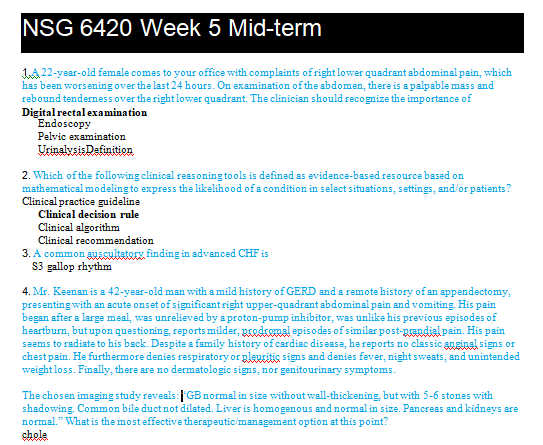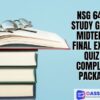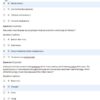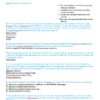Description
NSG 6420 Midterm Exam – Question and Answers
- A 22-year-old female comes to your office with complaints of right lower quadrant abdominal pain, which has been worsening over the last 24 hours. On examination of the abdomen, there is a palpable mass and rebound tenderness over the right lower quadrant. The clinician should recognize the importance of
- Which of the following clinical reasoning tools is defined as evidence-based resource based on mathematical modeling to express the likelihood of a condition in select situations, settings, and/or patients?
Clinical practice guideline - A common auscultatory finding in advanced CHF is
- Mr. Keenan is a 42-year-old man with a mild history of GERD and a remote history of an appendectomy, presenting with an acute onset of significant right upper-quadrant abdominal pain and vomiting. His pain began after a large meal, was unrelieved by a proton-pump inhibitor, was unlike his previous episodes of heartburn, but upon questioning, reports milder, prodromal episodes of similar post-prandial pain. His pain seems to radiate to his back. Despite a family history of cardiac disease, he reports no classic anginal signs or chest pain. He furthermore denies respiratory or pleuritic signs and denies fever, night sweats, and unintended weight loss. Finally, there are no dermatologic signs, nor genitourinary symptoms.
- A patient complains of fever, fatigue, and pharyngitis. On physical examination there is pronounced cervical lymphadenopathy. Which of the following diagnostic tests should be considered?
- Which of the following is not a contributing factor to the development of esophagitis in older adults?
- Essential parts of a health history include all of the following except:
- What test is used to confirm the diagnosis of appendicitis?
- The first assessment to complete related to the eyes is
- The best way to diagnose structural heart disease/dysfunction non-invasively is
- Which of the following is considered a “red flag” when diagnosing a patient with pneumonia
- In a patient presenting with suspected recurrence of diverticulitis, abdominal pain usually presents where in the abdomen?
- Mr. A presents to your office complaining of chest pain, mid-sternal and radiating to his back. He was mowing his lawn. He reports the pain lasting for about 8 minutes and went away after sitting down. What is his most likely diagnosis based on his presenting symptoms
- In autosomal recessive (AR) disorders, individuals need
- Susan P., a 60-year-old woman with a 30 pack year history, presents to your primary care practice for evaluation of a persistent, daily cough with increased sputum production, worse in the morning, occurring over the past three months. She tells you, “I have the same thing, year after year.” Which of the following choices would you consider strongly in your critical thinking process?
- The best evidence rating drugs to consider in a post myocardial infarction patient include:
- A 76-year-old patient with a 200-pack year smoking history presents with complaints of chronic cough, dyspnea, fatigue, hemoptysis, and weight loss over the past 2 months. The physical exam reveals decreased breath sounds and dullness to percussion over the left lower lung field. The chest X-ray demonstrates shift of the mediastinum and trachea to the left. These are classic signs of:
- Upon assessment of respiratory excursion, the clinician notes asymmetric expansion of the chest. One side expands greater than the other. This could be due to
- A patient presents with eye redness, scant discharge, and a gritty sensation. Your examination reveals the palpable preauricular nodes, which are most likely with:
- Emphysematous changes in the lungs produce the following characteristic in COPD patients?
- An older patient reports burning pain after ingestion of many foods and large meals. What assessment would assist the nurse practitioner in making a diagnosis of GERD?
- Which of the following details are NOT considered while staging asthma?
- The cytochrome p system involves enzymes that are generally Inhibited by drugs nsg 6420 midterm exam
- Mr. Keenan is a 42-year-old man with a mild history of GERD and a remote history of an appendectomy, presenting with an acute onset of significant right upper-quadrant abdominal pain and vomiting. His pain began after a large meal, was unrelieved by a proton-pump inhibitor, was unlike his previous episodes of heartburn, but upon questioning, reports milder, prodromal episodes of similar post-prandial pain. His pain seems to radiate to his back. Despite a family history of cardiac disease, he reports no classic anginal signs or chest pain. He furthermore denies respiratory or pleuritic signs and denies fever, night sweats, and unintended weight loss. Finally, there are no dermatologic signs, nor genitourinary symptoms.
- Jeff, 48 years old, presents to the clinic complaining of fleeting chest pain, fatigue, palpitations, lightheadedness, and shortness of breath. The pain comes and goes and is not associated with activity or exertion. Food does not exacerbate or relieve the pain. The pain is usually located under the left nipple. Jeff is concerned because his father has cardiac disease and underwent a CABG at age 65. The ANP examines Jeff and hears a mid-systolic click at the 4th ICS mid-clavicular area. The ANP knows that this is a hallmark sign of nsg 6420 midterm exam
- Men have faster and more efficient biotransformation of drugs and this is thought to be due to:
- An 82-year-old female presents to the emergency department with epigastric pain and weakness. She admits to having dark, tarry stools for the last few days. She-reports a long history of pain due to osteoarthritis. She self-medicates daily with ibuprofen, naprosyn, and aspirin for joint pain. On physical examination, she has orthostatic hypotension and pallor. Fecal occult blood test is positive. A likely etiology of the patient’s problem is:
- You have a patient complaining of vertigo and want to know what could be the cause. Knowing there are many causes for vertigo, you question the length of time the sensation lasts. She tells you several hours to days and is accompanied by tinnitus and hearing loss. You suspect which of the following conditions?
- Your patient has been ….for glaucoma for 5 years. Which of the following will provide indication of the level of progression during the funduscopic examination for this patient?
- If it has been determine a patient has esophageal reflux, you should tell them nsg 6420 midterm exam
- The following criterion is ….a positive finding when determining whether a patient with asthma can be safely monitored and treated at home:
- Jenny is a 24 year old graduate student that presents to the clinic today with complaints of fever, midsternal chest pain and generalized fatigue for the past two days. She denies any cough or sputum production. She states that when she takes Ibuprofen and rest that the chest pain does seem to ease off. Upon examination the patient presents looking very ill. She is leaning forward and states that this is the most comfortable position for her. Temp is 102. BP= 100/70. Heart rate is 120/min and regular. Upon auscultation a friction rub is audible. Her lung sounds are clear. With these presenting symptoms your initial diagnosis would be
- During auscultation of the chest, your exam reveals a loud grating sound at the lower anterolateral lung fields, at full inspiration and early expiration. This finding is consistent with:
- Your 35-year-old female patient complains of feeling palpitations on occasion. The clinician should recognize that palpitations are often a sign of
- Presbycusis is the hearing impairment that is ……with:
- Functional abilities are best assess by :
- In examining the mouth of an older adult with a history of smoking, the nurse practitioner finds a suspicious oral lesion. The patient has been referred for a biopsy to be sent for pathology. Which is the most common oral precancerous lesion?
- The aging process causes what normal physiological changes in the heart?
- In assessing the eyes, which of the following is …a “red flag” finding when associated with eye redness?
- Helicobacter pylori is …..as a causative agent in the development of duodenal or gastric ulcers. What teaching should the nurse practitioner plan for a patient who has a positive Helicobacter pylori test?








